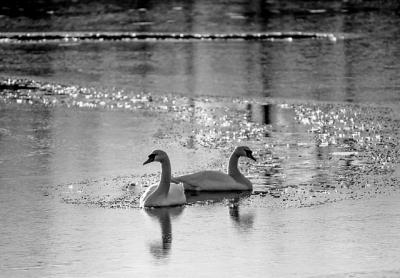Nature Notes: Birds Abound in Montauk Count

On Dec. 15 one of the oldest Christmas Bird Counts took place in East Hampton, the Montauk Count. Seven territories were covered by different observers — Montauk Point north, Montauk Point south, Lake Montauk west (including Hither Hills), Napeague, Accabonac in Springs, and the annual plum, Gardiner’s Island. In an unofficial tally of 5,501 birds, a total of 118 species were seen and counted under the direction of Karen Rubinstein.
Among the winter-resident birds counted were 477 white-throated sparrows, 8 white-crowned sparrows, 40 snow buntings, 136 juncos, 5 purple finches, 1 redpoll, 45 pine siskins, 35 fox sparrows, 2 tree sparrows, 27 yellow-rumped warblers, 38 hermit thrushes, 5 winter wrens, 13 saw-whet owls, 1 snowy owl, 1,898 razorbills, 4 Iceland gulls, 281 gannets, 2 rough-legged hawks, 6 red-necked grebes, 71 horned grebes, 496 common loons, 2,469 red-throated loons, 1 Barrows goldeneye, 2 harlequin ducks, 1,445 common eiders, 830 long-tailed ducks (formerly, old squaw), 283 bufflehead, 74 ruddy ducks, 3 common mergansers (a low), 31 hooded mergansers, 43 greater scaups, 8 canvasbacks, 458 surf scoters, 961 black scoters, and 2,806 white-winged scoters. In duck hunter parlance all scoters are called “coots.”
It is not surprising that of the 4,225 scoters in total, more than half were in the Gardiner’s Island area, which sees comparatively less waterfowl hunting than the six other survey areas. The same can be said for horned grebes (not a game species). More than half were observed in the Gardiner’s Island count area. Scoter species are usually found in high numbers during the winter in the Long Island area, but the 1,445 common eiders counted is unusual. Global warming may be stunting some local species with respect to breeding, but it seems that common eiders may be given a breeding boost. The same may be said for the 281 gannets observed.
Global warming may account for the large number of spring and summer breeders such as the large number of stay-behind robins (673), song sparrows (585), catbirds (56), and red-winged blackbirds (53) counted.
Many bird species that used to show up in the winter on earlier counts that I attended on Gardiner’s Island — purple finch (5), red crossbill (0), common redpoll (1) — were either lacking altogether or in very short supply.
Lastly, those birds that are generally here all year, such as crows, herring gulls, and the like, were in good supply. There were 381 of the former and a whopping 1,795 of the latter counted. There were 481 chickadees, 88 tufted titmice, 431 blue jays, 186 Carolina wrens, and 247 mourning doves observed. Only one of the latter was seen on Gardiner’s Island, where birdfeeders are very few or none at all.
Some of the unusual occurrences were the two ravens observed in the Accabonac area, the two pipits counted in Montauk south, and the four tree swallows and one rough-legged hawk on Gardiner’s Island. Birds that are not “natives,” such as the starling (623), mute swan (21), house sparrow (133), and rock dove (219) from Europe, and the house finch (101) from the southwestern United States, are apparently holding their own.
Wild turkeys, which used to be here on Long Island but were missing for almost 200 years, are back in good numbers now. Seventy-five were counted in all, 43 on Gardiner’s Island, where they have been since the early 1960s.
Pretty good day’s work, don’t you think? Nice job, Karen!
